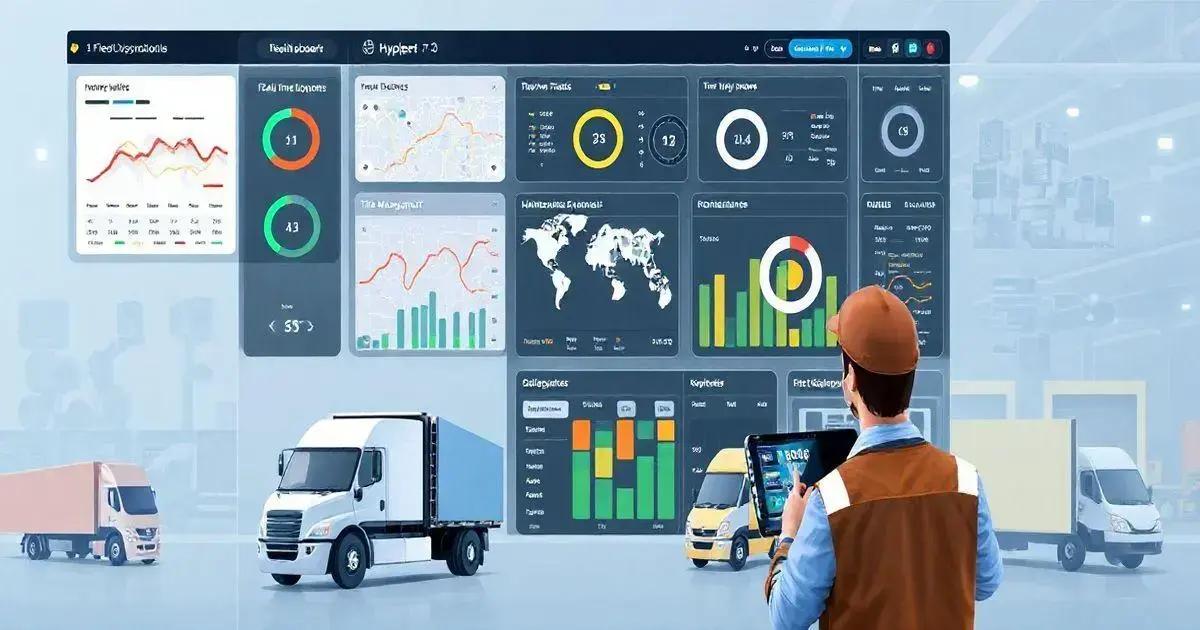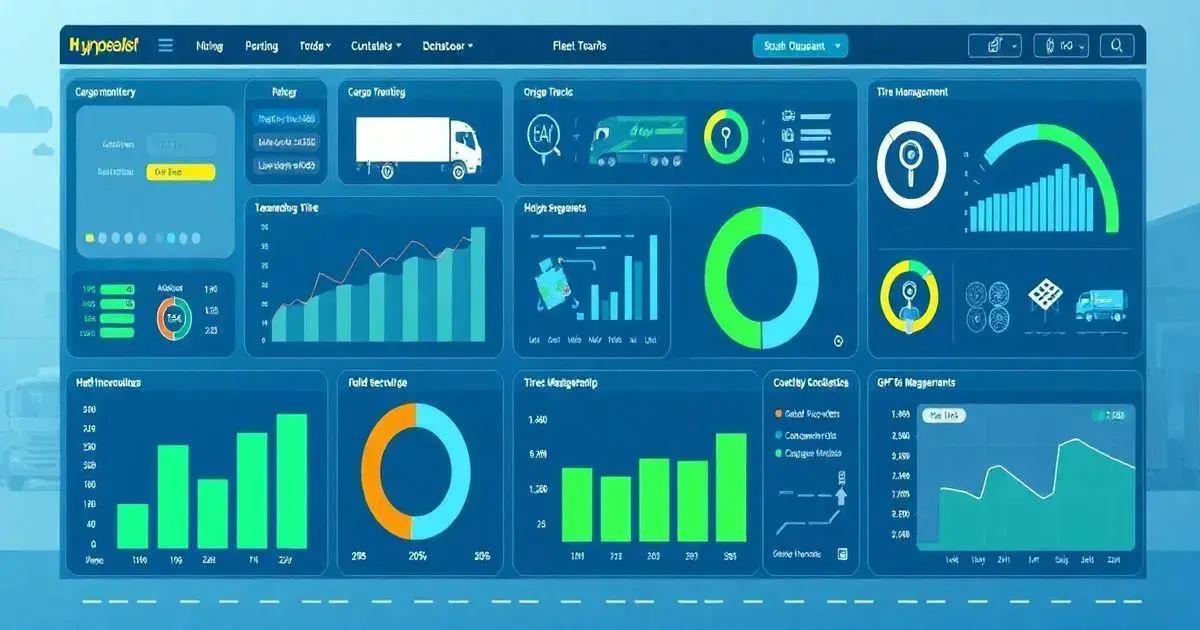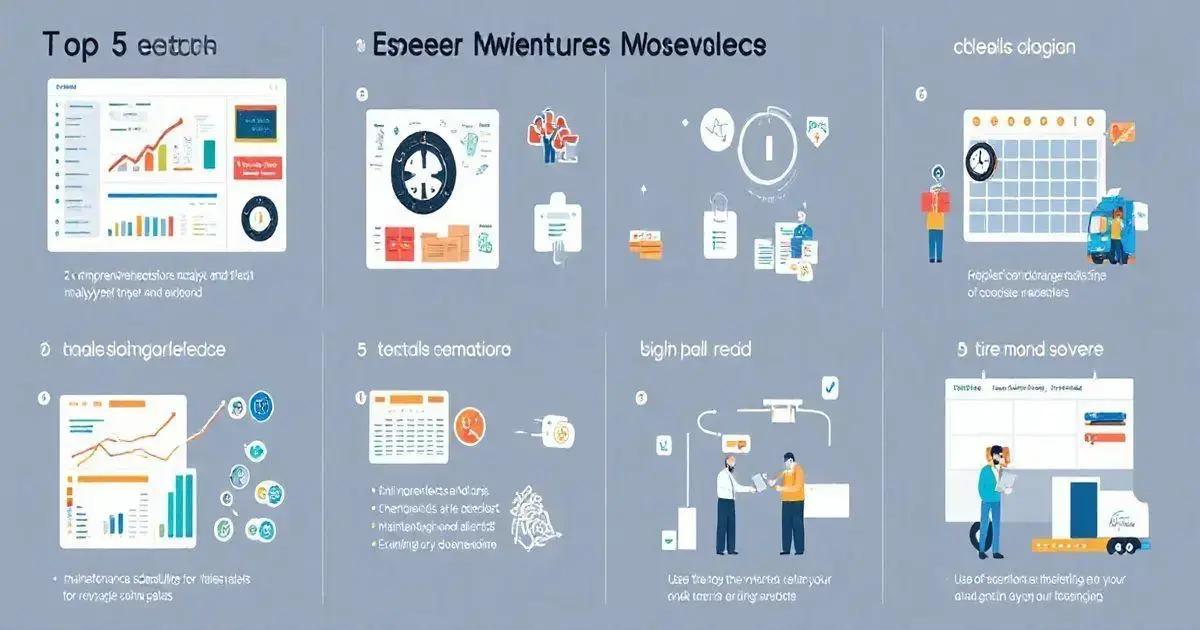Top 5 Features of Fleet Control Worksheet 7.0 You Must Know Leave a comment
The Fleet Control Worksheet 7.0 is an advanced management tool that enhances logistics and vehicle maintenance for fleet operators by providing features such as dashboards for tracking kilometers driven, fuel consumption, and maintenance costs, along with driver and vehicle registrations, document management, travel control, and maintenance strategies to improve operational efficiency and decision-making.
The Fleet Control Worksheet 7.0 is an essential tool for managing logistics and fleet maintenance efficiently.
This updated version offers a comprehensive dashboard, travel and cargo control, tire management, maintenance scheduling, and more to optimize your fleet operations.
Initial Dashboards: Key Metrics
The Fleet Control Worksheet 7.0 features an impressive array of dashboards that provide vital insights into your fleet’s performance at a glance. Here are some of the key metrics included:
- KM by Driver: This metric tracks the total kilometers driven by each driver, helping you identify who is driving the most and ensuring fair allocation of resources.
- KM per Vehicle: Monitor the mileage of individual vehicles in your fleet. This helps in scheduling maintenance and understanding usage patterns.
- KM per Liter: Evaluate fuel efficiency by calculating the kilometers driven per liter of fuel consumed, which can reveal potential areas for improvement in driving habits or vehicle performance.
- KM per Trip: Analyze how far each trip is, enabling you to assess the efficiency of routes and making adjustments as necessary to optimize travel time and costs.
- Average Consumption per Vehicle: Keep tabs on the average fuel consumption for each vehicle, which assists in managing fuel costs effectively and pinpointing any anomalies in fuel use.
- Average Consumption per Driver: Understand how each driver’s habits impact fuel consumption, giving you the opportunity to implement training or incentives for more efficient driving practices.
- Total General, Preventive and Corrective Maintenance: This metric aggregates all maintenance tasks performed, allowing you to assess the overall health of your fleet and schedule future maintenance accordingly.
- Maintenance Cost Average: Analyze the average costs associated with maintenance to budget effectively and prevent unexpected expenses.
- Total Cost of Mechanical and Electrical Maintenance: Understand how much has been spent on mechanical and electrical repairs to ensure budgets are adhered to and to identify any trends.
- Total Tire Maintenance Cost: Tracking this cost helps in managing tire replacement schedules and evaluating overall tire management efficiency.
- Total Lubricant Cost: This allows you to keep a check on lubricant expenses, ensuring that your fleet operates under optimal conditions.
- Average Cost of Mechanical and Electrical Maintenance: Having a grip on the average costs lets you predict future maintenance costs and manage your finances better.
- Average Tire Maintenance Cost: Monitoring average costs per tire can aid in timely replacements and budgeting for future tire purchases.
- Average Cost with Lubricants: Knowing how much is spent on lubricants can ensure efficient budgeting and management of these essential maintenance materials.
- Vehicles in Transit: Track how many vehicles are currently in transit, which can help in fleet scheduling and operational efficiency.
- Tires in Transit: Monitoring tire availability and usage helps prevent shortages and ensures all vehicles are ready to go.
- Delayed Vehicle Documents: Keep track of any outstanding paperwork for vehicles, ensuring compliance and readiness for inspections or audits.
- Delayed Driver Documents: Similarly, monitoring driver documentation helps maintain regulatory compliance and readiness for road usage.
- Delayed Preventive Maintenance: This metric serves as a reminder for necessary preventive maintenance tasks that may be overdue, helping to avoid costly repairs down the line.
- Total Cost Versus Shipping: Analyze how costs correlate with shipping expenses to evaluate profitability and operational efficiency.
- Fuel, Maintenance and Other Costs: A comprehensive view of all costs allows for better budgeting and financial planning for the fleet.
These dashboards not only simplify tracking but also enable proactive management of your fleet, ensuring that you can make informed decisions that enhance efficiency and cut costs.

Registrations: Driver and Vehicle Management
The Fleet Control Worksheet 7.0 includes a comprehensive registration system designed to streamline the management of both drivers and vehicles within your fleet. This section focuses on the essential components involved in maintaining accurate and up-to-date records.
Here are the key elements you’ll manage through the registration system:
- Driver Registration: Each driver in your fleet must be registered to ensure compliance with regulations and facilitate tracking. This includes collecting personal details, license information, and driving records. By maintaining a complete database, you can monitor driver performance and ensure that only qualified personnel operate your vehicles.
- Vehicle Type Registration: Registering each type of vehicle within your fleet allows for better categorization and management. This includes details such as make, model, year of manufacture, and other specifications. Understanding the capabilities and limitations of each vehicle type aids in effective fleet allocation and route planning.
- Mechanical and Electrical Services Registry: Keeping a record of all mechanical and electrical services performed on vehicles is crucial for tracking maintenance history. This registry helps in scheduling future services based on previous repairs and ensuring that all vehicles are operating safely and efficiently.
- Tree Service Registration: This includes documenting any tree-related services that may be provided by your fleet, ensuring compliance with local regulations and environmental standards. It’s essential for fleets involved in utility or landscaping services.
- Lubricant Services Register: Maintaining a record of lubricant services ensures that all vehicles receive the necessary maintenance to keep them running smoothly. This can help you track lubricant usage and costs, making it easier to budget for future purchases.
- Register of Workshops and Suppliers: Having a reliable list of workshops and suppliers enables quick access to necessary services and parts. This registry helps streamline the procurement process and ensures that your vehicles are serviced by trusted professionals.
- Expenditure Type Register: This helps in tracking different types of expenditures associated with your fleet, providing insights into where your budget is being allocated. Understanding these costs can help identify areas for savings and better financial planning.
- Refueling Station Registration: Keep a record of preferred or assigned refueling stations, which can aid in controlling fuel expenses and ensuring that drivers know where to refuel without incurring excess costs.
- Fuel Type Register: Maintaining records of fuel types used for each vehicle can help in managing fuel efficiency and costs. This knowledge is critical for fleets that operate with various fuel types, such as diesel, gasoline, or alternative fuels.
By efficiently managing driver and vehicle registrations, the Fleet Control Worksheet 7.0 enables fleet managers to maintain compliance, optimize operations, and ensure that both drivers and vehicles are effectively utilized.
Document Management: Efficient Record Keeping
The Fleet Control Worksheet 7.0 includes a robust document management system that is essential for maintaining organized and accessible records for both drivers and vehicles. Efficient record-keeping is crucial for compliance, operational efficiency, and risk management.
Here are the primary components of the document management system:
- Driver Document Control: This feature allows you to manage all necessary documents for each driver efficiently. It includes tracking licenses, certifications, training records, and any other relevant paperwork. By ensuring that all driver documents are current, you enhance compliance and reduce liability risks.
- Vehicle Document Control: Similar to driver documents, this feature helps manage all vehicle-related paperwork, including registration, insurance, inspection certificates, and service records. Keeping these documents organized ensures that each vehicle is compliant with regulations and ready for inspections, helping to avoid fines and downtime.
- Automated Reminders for Expiry Dates: The document management system can be programmed to send automated reminders for upcoming renewals or expirations of driver licenses, vehicle registrations, and insurance policies. This proactive approach minimizes the risk of operating with expired documents.
- Centralized Document Storage: All documents associated with drivers and vehicles can be stored in a centralized digital repository. This accessibility allows fleet managers to quickly retrieve necessary documents when needed, whether for audits, inspections, or routine checks.
- Document Version Control: Keeping track of different versions of important documents is essential. The Fleet Control Worksheet allows for versioning, ensuring that the most current documents are used while retaining access to previous versions for reference if needed.
- Integration with Compliance Regulations: The document management feature can be set to align with local and industry-specific compliance regulations, ensuring that all required documentation is maintained and accessible. This reduces the risk of non-compliance and related penalties.
- Secure Access Control: To protect sensitive information, the document management system includes access control features. Only authorized personnel can view or edit specific documents, enhancing data security and privacy.
By implementing an efficient document management system in the Fleet Control Worksheet 7.0, fleet managers can ensure that all required documentation is properly maintained, easily accessible, and compliant with regulations. This not only enhances operational efficiency but also mitigates risks associated with documentation errors.

Travel Control: Monitoring Cargo and Expenses
The Fleet Control Worksheet 7.0 provides a comprehensive travel control system designed to efficiently monitor cargo and related expenses associated with each trip. This feature is essential for optimizing logistics and ensuring cost-effectiveness in fleet operations.
Key aspects of the travel control module include:
- Cargo Control Linked to Trips: Each trip can be directly linked to the cargo being transported, allowing for clear tracking of what is being moved, when, and by whom. This linkage helps with accountability and ensures that all cargo is properly documented and monitored throughout its journey.
- Vehicle Control: Track which vehicle is assigned to each trip, including details such as vehicle condition, capacity, and suitability for the cargo. This helps in optimizing vehicle usage and reducing wear and tear by ensuring the correct vehicle is used for each job.
- Driver Control: Assign specific drivers to trips and monitor their performance and compliance during transport. This not only helps with accountability but also allows for performance evaluation and training opportunities based on trip outcomes.
- Supply Control: Manage and monitor all supplies required for each trip, including fuel, maintenance, and other operational necessities. Keeping track of supplies ensures that drivers are well-equipped and helps prevent delays due to shortages.
- Control of All Travel Expenses: This feature allows for detailed tracking of all expenses incurred during travel, such as fuel, tolls, maintenance, and any other costs. By monitoring these expenses, fleet managers can identify cost-saving opportunities and ensure that budgets are adhered to.
- Expense Reporting: Generate detailed reports on travel expenses that can be analyzed for trends and insights. Understanding expense patterns can help in making informed decisions regarding budget allocations, route optimizations, and operational improvements.
- Integration with Accounting Systems: The travel control module can be integrated with existing accounting systems to streamline the accounting process. This integration helps ensure that all travel-related expenses are accurately recorded and reflected in financial reports.
By effectively monitoring cargo and expenses through the Fleet Control Worksheet 7.0, fleet managers can enhance operational efficiency, reduce costs, and ensure that all travel activities are well-coordinated and documented.
Maintenance Control: Preventive and Corrective Actions
The Fleet Control Worksheet 7.0 features a dedicated maintenance control system that focuses on both preventive and corrective actions, ensuring that your fleet remains in optimal working condition. Efficient maintenance management plays a crucial role in reducing downtime and extending the lifespan of your vehicles.
Here are the key components of the maintenance control module:
Maintenance Control: Preventive and Corrective Actions
- Corrective and Preventive Maintenance Type: The system categorizes maintenance into two types: corrective and preventive. Corrective maintenance addresses repairs needed due to vehicle malfunctions, while preventive maintenance focuses on scheduled service tasks to prevent issues before they arise. This dual approach helps maintain vehicle reliability.
- Maintenance by Vehicle: Track maintenance schedules, repairs, and service history for each vehicle individually. This detailed tracking allows fleet managers to understand each vehicle’s specific needs, ensuring timely interventions and proper care.
- Maintenance by Mechanical and Electrical Type: Clearly delineate maintenance requirements based on mechanical or electrical components. This helps prioritize tasks and allocate resources effectively, ensuring that both types of maintenance are addressed promptly.
- Maintenance Cost: Monitor the costs associated with maintenance activities. Keeping a close eye on maintenance expenses allows for better budgeting and identifying trends in repair costs, which can inform decision-making regarding fleet upgrades or replacements.
- Preventive Maintenance Schedule: Establish a regular schedule for preventive maintenance tasks, such as oil changes, inspections, and tire rotations. Adhering to a preventive maintenance schedule helps prevent mechanical breakdowns and extends the life of the vehicles.
- Preventive Maintenance Signal: Utilize alerts and reminders within the system to ensure that preventive maintenance tasks are not overlooked. This proactive approach minimizes the risk of unexpected vehicle issues that could disrupt operations.
- Status by: Scheduled, Accomplished and Delayed: Keep track of the status of maintenance tasks. Categorizing tasks as scheduled, accomplished, or delayed provides visibility into maintenance operations and helps in planning future maintenance activities.
By implementing the maintenance control features in the Fleet Control Worksheet 7.0, fleet managers can ensure that all vehicles are maintained efficiently, reducing the likelihood of breakdowns and improving overall fleet performance.
Conclusion
The Fleet Control Worksheet 7.0 is an invaluable tool for fleet managers looking to optimize their operations and ensure the longevity of their vehicles.
By effectively managing critical areas such as driver and vehicle registrations, document control, travel monitoring, and maintenance, you can create a more efficient and productive fleet.
Implementing a system that tracks key metrics, enables proactive maintenance, and monitors travel expenses allows for informed decision-making and better resource allocation.
With features designed for both preventive and corrective actions, you can minimize downtime and maintain regulatory compliance.
By leveraging the capabilities of the Fleet Control Worksheet 7.0, you’re not just managing a fleet; you’re enhancing operational efficiency, reducing costs, and ultimately driving the success of your logistics operations.
FAQ – Frequently Asked Questions about Fleet Control Worksheet
What is the Fleet Control Worksheet 7.0?
The Fleet Control Worksheet 7.0 is a comprehensive tool designed for managing logistics and maintenance of fleet vehicles, featuring dashboards, document management, and travel control.
How does the document management system work?
The document management system allows users to efficiently track and manage essential documents for drivers and vehicles, ensuring compliance and accessibility.
What are the key features of the travel control module?
The travel control module includes cargo tracking, vehicle and driver management, expense monitoring, and supply control to optimize logistics operations.
How can I ensure regular maintenance of my vehicles?
By using the maintenance control features, you can schedule preventive maintenance tasks and set up alerts to ensure timely servicing of vehicles.
Is training available for using the Fleet Control Worksheet 7.0?
Yes, users can access training resources and support to help them understand and utilize the features of the Fleet Control Worksheet effectively.
Can the Fleet Control Worksheet be integrated with other systems?
Yes, the worksheet supports integration with existing accounting and fleet management systems to streamline operations and improve data accuracy.

